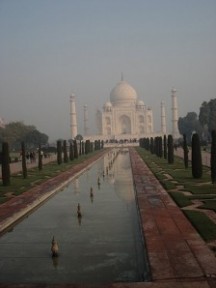Was love in the 1600s really simpler than today? These days we can get away with jewellery, chocolates and even roses. But back in the 17th century, Shah Jahan put his love for his wife Mumtaz on display with what became one of the Seven Wonders of the World, the Taj Mahal.
Despite several trips to Delhi in my childhood, I first visited the Taj Mahal in Agra only in 2010. I was accompanied by my cousins and friends. We had some really bad luck, as everyone we met was just not interested in giving us directions. Though road signs started late, due credit goes to the State Transport Department who chose to count down the distance to the Taj in as much detail as every metre, but unfortunately missed out on erecting a sign at the most crucial sharp left turn. Alas! Perhaps the idea was to make finding the monument as difficult as finding love as pure and true as Shah Jahan’s.
So we were left with just the dawn to see the magnificent structure. And if two of the three people you are travelling with love to sleep till noon, waking them up before dawn is a true feat, perhaps even more difficult than finding the Taj itself. The biting January cold did not make it one bit better.
So there we were being haggled by guides to let them show us the Taj. Any bright ideas to even walk the distance fizzled out when we found out it was more than two km away and so a horse carriage was the choice.
As we passed the rooms where the labourers lived, the main gate of the Taj Mahal was visible, with its 21 domes in two rows on top, one for each year it took to build the Taj. Thank God we took a guide along. Why were there so many entrances, why is the Taj open for night viewing only during a full moon, and what were the other two sandstone structures that guarded the beautiful monument? We would have been none the wiser.
While the precision and symmetry within the Taj is spectacular, it’s the marble carvings that really catch your attention. Each flower and each leaf is carved out of blocks of marble with such grace and accuracy, it makes you wonder what would happen to that entire block of marble, had the carver taken a wrong turn.
Behind the Taj Mahal stands the foundation of what could have been a similar structure in black marble. It would have surely been a sight with both standing upright, facing each other from across the Yamuna. Could the black marble marvel have overpowered it’s virgin twin?
Though January was not the peak time to visit Agra, because of the biting cold, it didn’t stop visitors from flocking. Why? Perhaps they all wanted to know for themselves how the love that bloomed in the 1600s still stands strong.
Faye Rodrigues is employed full-time, but makes time to put pen to paper in pursuing her passion for writing. Her dream is to travel the world and write about her adventures. Her passion for travel goes beyond merely reaching a destination – it lies in the adventure of getting there. She believes in the motto – “Live like everyday is your last… Love as though no one is watching you… Write like it’s your only means of communication… Travel as though the world is next door.”






